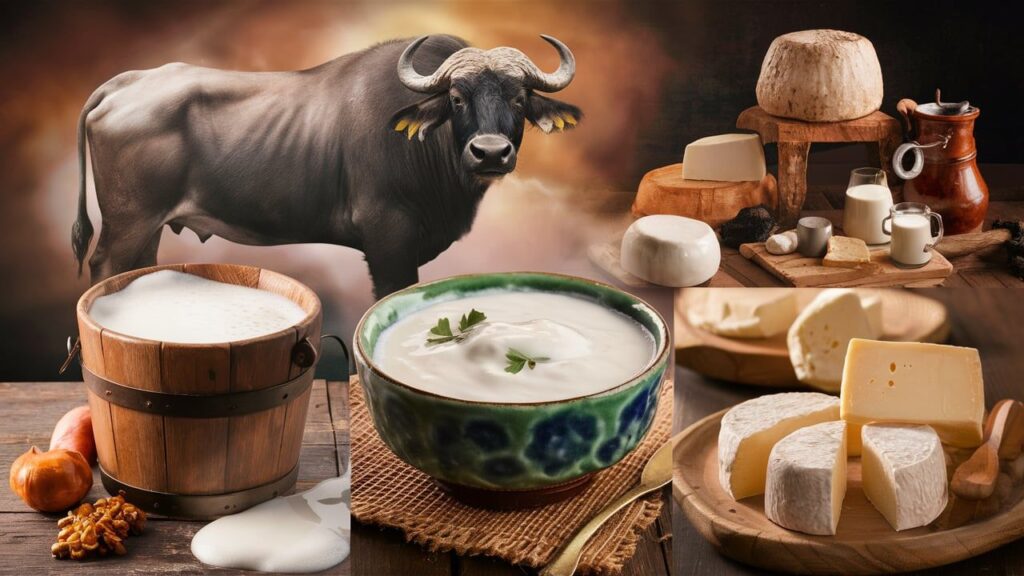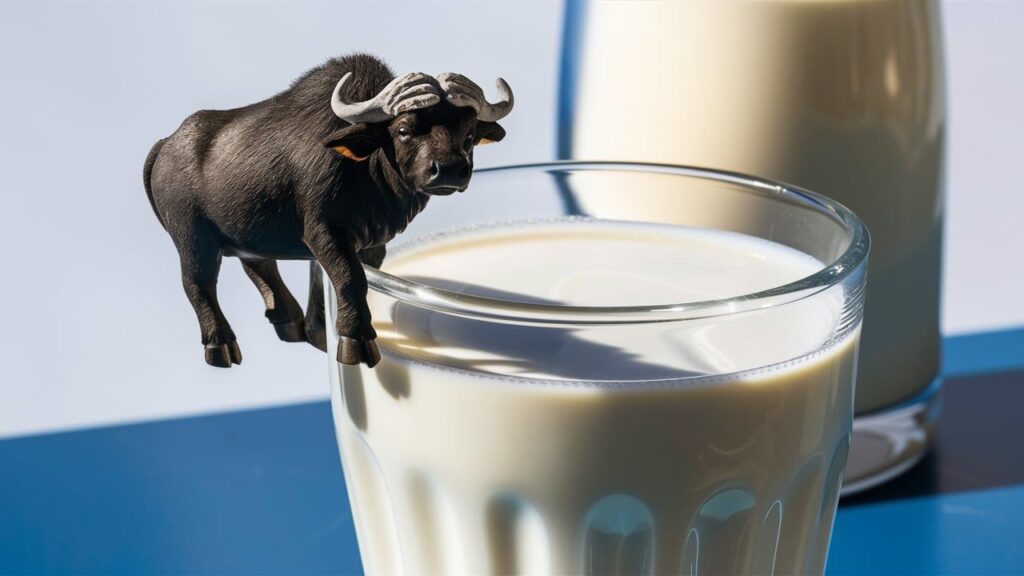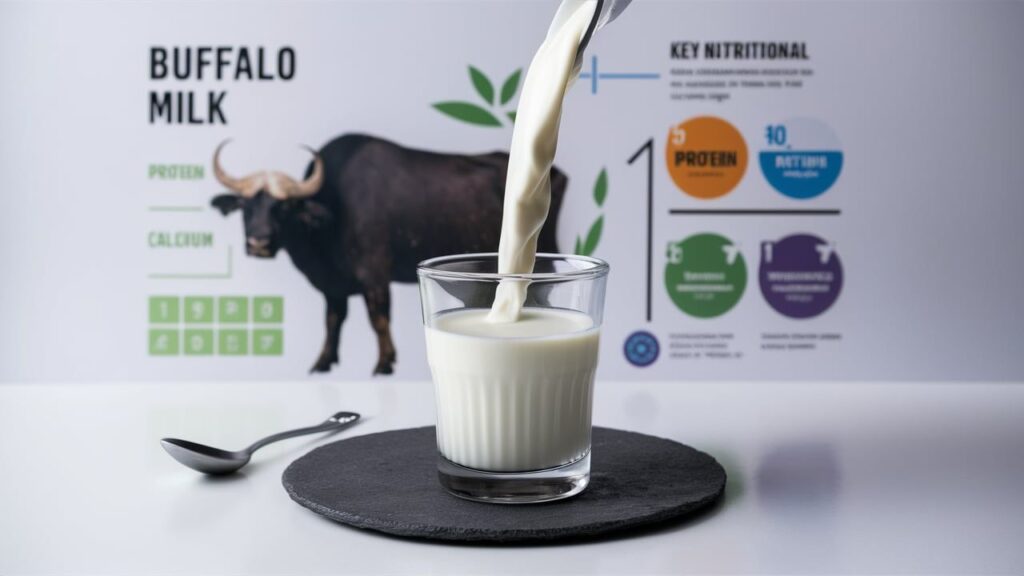Buffalo milk is increasingly appreciated for its thick, creamy consistency and superior nutritional profile, making it a popular choice among dairy consumers. This milk offers numerous health benefits, making it a valuable addition to any diet. In this article, we explore the wonders of buffalo milk, discussing its nutritional value, benefits, uses, and how it compares to cow’s milk.
What is Buffalo Milk?

Buffalo milk comes from domesticated water buffaloes, commonly found in Asia, parts of Europe, and other regions. Known for its thicker and creamier consistency compared to cow’s milk, buffalo milk is a favorite ingredient in various traditional and modern dishes.
How to Identify Buffalo Milk?

Identifying buffalo milk can be important for those who prefer its unique taste and nutritional benefits or need to avoid it due to dietary restrictions. Here are some ways to identify buffalo milk:
Visual Characteristics
- Color and Consistency: Buffalo milk is generally whiter and thicker than cow’s milk. The high-fat content gives it a more opaque appearance and a creamier texture.
- Cream Layer: Buffalo milk often has a noticeable layer of cream that rises to the top if left standing, especially if it’s raw or minimally processed. This is due to the higher fat content in buffalo milk.
Taste and Smell
- Taste: Buffalo milk has a richer, more intense flavor compared to the milder taste of cow’s milk. Some describe it as being sweeter or creamier.
- Smell: The scent of buffalo milk is generally more pronounced and slightly different from cow’s milk. This difference might not be obvious to everyone but can be noticeable to those familiar with both types.
Packaging and Labeling
- Labels: Always check the label when buying milk. Manufacturers usually specify whether the milk is from buffaloes. Look for terms like “buffalo milk,” “buffalo mozzarella,” or regional names like “Búfala” in some areas.
- Brand and Origin: Certain brands specialize in buffalo milk products. Familiarizing yourself with these brands or asking your retailer can help ensure you are purchasing buffalo milk.
Chemical Tests
- Fat Level Check: Buffalo milk typically contains a higher fat percentage (approximately 7-8%) compared to cow’s milk, which usually has around 3-4% fat. A simple cream test can be done at home: after boiling and cooling, buffalo milk will have a thick layer of cream, while cow’s milk will have a thinner layer.
- Protein and Lactose Tests: Laboratory tests can determine the protein and lactose content, which differ between buffalo and cow’s milk. However, these tests are typically performed by professionals.
Geographic and Regional Availability
- Availability: Buffalo milk is more commonly found in regions where buffaloes are prevalent, such as South Asia, parts of Europe, and the Middle East. Knowing the common types of milk in your area can help in identification.
Expert Advice
- Consult Professionals: Dairy farmers, vendors, or nutritionists can often identify buffalo milk and provide guidance based on physical characteristics and taste.
Wellhealthorganic Buffalo Milk tag Benefits and Side Effect

Benefits
| Benefit | Description |
|---|---|
| High Nutritional Value | Contains more protein, calcium, vitamins (A, B12), and minerals (phosphorus, magnesium) than cow’s milk. |
| Supports Bone Health | Rich in calcium and phosphorus, which help maintain strong bones and teeth and prevent osteoporosis. |
| Enhances Muscle Health | High protein content supports muscle growth, repair, and overall maintenance. Beneficial for athletes and recovery. |
| Boosts Immune System | Vitamins A and B12, along with antioxidants, help strengthen the immune system and combat infections. |
| Improves Digestive Health | Slightly lower in lactose than cow’s milk, may be easier to digest for some. Probiotics in yogurt and kefir aid gut health. |
| Supports Heart Health | Contains beneficial fatty acids like conjugated linoleic acid (CLA), which may improve cardiovascular health. |
| Skin and Hair Benefits | The fat and lactic acid in buffalo milk nourish and moisturize skin and hair, beneficial in cosmetic products. |
Potential Side Effects
| Side Effect | Description |
|---|---|
| High Fat Content | Higher in calories and saturated fat, which could impact weight management and cholesterol levels. |
| Lactose Intolerance | Contains lactose, which may cause digestive discomfort in individuals with severe lactose intolerance. |
| Allergic Reactions | Potential for milk protein allergies, which can cause symptoms like hives, swelling, or gastrointestinal issues. |
| Cost and Availability | Often more expensive and less readily available than cow’s milk, which may be a concern for some consumers. |
| Raw Milk Risks | If consumed raw, may carry risks of bacterial infections. Pasteurization is recommended to avoid health risks. |
Nutritional Value of Buffalo Milk

Buffalo milk is recognized for its nutrient-dense composition, making it a beneficial component of a well-rounded diet. Compared to cow’s milk, buffalo milk contains higher levels of fats, proteins, and certain minerals, which contribute to its creamy texture and enhanced health benefits. Let’s delve into the nutritional elements of buffalo milk and understand their importance.
Key Nutrients in Buffalo Milk
Buffalo milk’s nutritional content is higher than cow’s milk in several areas, making it a more nutrient-dense option. Buffalo milk contains several key nutrients, including:
- Fats
- Buffalo milk contains approximately 7-8% fat, significantly higher than cow’s milk, which usually contains around 3-4%. This high-fat content contributes to the milk’s rich and creamy consistency and provides essential fatty acids that are beneficial for the body.
- Proteins
- With a protein content of around 8-10%, buffalo milk is a rich source of high-quality proteins. These proteins are crucial for building and repairing tissues, producing enzymes and hormones, and supporting overall body functions.
- Calcium
- Buffalo milk is an excellent source of calcium, offering up to 35% more calcium than cow’s milk. Calcium is vital for maintaining strong bones and teeth, and it also plays a critical role in muscle function and nerve signaling.
- Vitamins
- Buffalo milk is rich in vitamins such as Vitamin A and B12. Vitamin A is important for vision, immune function, and skin health, while Vitamin B12 is essential for red blood cell formation and neurological function.
- Minerals
- Apart from calcium, buffalo milk provides other essential minerals like phosphorus, magnesium, and potassium. These minerals support various bodily functions, including bone health, energy production, and electrolyte balance.
- Lactose
- Buffalo milk contains slightly less lactose than cow’s milk, making it potentially easier to digest for individuals with lactose intolerance.
- Antioxidants
- The presence of antioxidants in buffalo milk helps protect the body against oxidative stress and free radical damage, which can lead to chronic diseases.
Table: Nutritional Composition of Buffalo Milk (per 100ml)
| Nutrient | Buffalo Milk (Approx. per 100ml) | Significance |
|---|---|---|
| Energy | 110-120 kcal | High energy content supports daily caloric needs |
| Fat | 7-8g | Essential fatty acids, provides energy, and aids in vitamin absorption |
| Protein | 8-10g | Supports muscle growth, repair, and overall body functions |
| Calcium | 195-210mg | Essential for bone and teeth health |
| Vitamin A | 250-300 IU | Important for vision, skin health, and immune function |
| Vitamin B12 | 0.5-0.7 mcg | Crucial for nerve function and red blood cell formation |
| Phosphorus | 140-150mg | Works with calcium to maintain strong bones and teeth |
| Magnesium | 18-25mg | Vital for muscle function, nerve signaling, and bone health |
| Potassium | 115-130mg | Helps maintain proper heart function and fluid balance |
| Lactose | 4-5g | Carbohydrate providing energy, slightly lower than in cow’s milk |
| Antioxidants | Present | Protects against oxidative stress and supports overall health |
Health Implications of Buffalo Milk’s Nutritional Profile
- Heart Health
- While high in fat, buffalo milk contains beneficial fatty acids, such as conjugated linoleic acid (CLA), which may help reduce body fat and improve cardiovascular health. The balance of essential nutrients also supports overall heart health.
- Bone Health
- The high calcium and phosphorus content in buffalo milk make it an excellent choice for maintaining strong bones and teeth. These nutrients are particularly important for children, adolescents, and older adults who are more susceptible to bone density loss.
- Immune System Support
- Vitamins A and B12, along with antioxidants found in buffalo milk, contribute to a stronger immune system. These nutrients help the body fight off infections and reduce the risk of chronic diseases.
- Muscle Development and Repair
- The high protein content in buffalo milk supports muscle growth and repair, making it a valuable addition to the diet of athletes, bodybuilders, and individuals recovering from illness or injury.
- Digestive Health
- Some people with lactose intolerance find buffalo milk easier to digest due to its slightly lower lactose content compared to cow’s milk. Additionally, the rich composition of buffalo milk can aid in digestive health by providing necessary fats and proteins.
Uses of Buffalo Milk

Buffalo milk’s unique properties make it a versatile ingredient in various culinary and non-culinary applications. Its rich fat content, creamy texture, and nutrient density lend themselves to a wide range of products and dishes. Here’s a closer look at how buffalo milk is utilized:
Culinary Uses
Buffalo milk is a staple in many traditional and modern recipes. It is valued for its capability to enrich the taste and texture of dishes.
- Dairy Products: Buffalo milk is ideal for producing dairy products due to its higher fat content and rich texture. It is commonly used to make:
- Cheese: Buffalo milk is renowned for its role in crafting mozzarella cheese, especially cherished in Italian cuisine. It also makes excellent paneer, ricotta, and other cheeses.
- Butter: The high-fat content allows for a richer, creamier butter.
- Yogurt: Buffalo milk yogurt is thicker and creamier than that made from cow’s milk, often used in desserts and savory dishes.
- Ghee: Clarified butter made from buffalo milk is widely used in South Asian cuisine.
- Cooking and Baking: The creamy texture of buffalo milk enhances various dishes. It is commonly used in:
- Sauces and Soups: Adds richness and depth of flavor.
- Baking: Used in cakes, pastries, and breads for a moist and tender crumb.
- Desserts: Ideal for custards, ice creams, and puddings due to its creamy texture.
- Beverages: Buffalo milk is used in traditional and modern drinks. It can be enjoyed on its own or utilized in various ways such as:
- Lassi: A traditional yogurt-based drink popular in India.
- Kefir: A probiotic-rich fermented milk beverage.
- Milkshakes: Adds a creamy, rich texture to milkshakes.
Non-Culinary Uses
Beyond the kitchen, buffalo milk and its derivatives have applications in non-culinary fields:
- Cosmetic Products: The lactic acid and fats in buffalo milk are beneficial for skin care. It is used in:
- Soaps: Known for moisturizing and nourishing the skin.
- Creams and Lotions: Helps in hydrating and softening the skin.
- Hair Care: Used in conditioners and masks for nourishing hair.
- Nutritional Supplements: Due to its high nutrient content, buffalo milk is sometimes used in supplements aimed at enhancing protein and calcium intake.
Table: Detailed Uses of Buffalo Milk
| Category | Specific Use | Description |
|---|---|---|
| Dairy Products | Cheese | Buffalo mozzarella, paneer, ricotta |
| Butter | Creamy and rich, ideal for spreading and cooking | |
| Yogurt | Thicker and creamier than cow’s milk yogurt | |
| Ghee | Clarified butter used in South Asian cuisine | |
| Cooking & Baking | Sauces and Soups | Adds creaminess and richness |
| Baking | Enhances texture and moisture in cakes, pastries | |
| Desserts | Used in ice creams, custards, and puddings | |
| Beverages | Lassi | A traditional yogurt drink, sweet or savory |
| Kefir | Fermented milk drink, rich in probiotics | |
| Milkshakes | Provides a rich and creamy texture | |
| Cosmetic Products | Soaps | Moisturizing and nourishing properties for skin |
| Creams and Lotions | Used for hydrating and softening skin | |
| Hair Care | In conditioners and masks, helps nourish hair | |
| Nutritional Supplements | Protein and Calcium Supplements | High in essential nutrients, used in dietary supplements |
Comparison: Buffalo Milk vs. Cow’s Milk
Below is a comparison of buffalo milk and cow’s milk in terms of nutritional content:
| Component | Buffalo Milk | Cow’s Milk |
|---|---|---|
| Fat | 7-8% (higher and creamier) | 3-4% (lower fat content) |
| Protein | Higher (8-10%) | Lower (3-4%) |
| Calcium | More (up to 35% more calcium) | Less |
| Vitamins | Rich in A and B12 | Lower levels of A and B12 |
| Lactose | Lower (easier for some to digest) | Higher (may cause intolerance) |
| Texture | Thicker and richer | Thinner and lighter |
Buffalo Milk Benefits for Skin

- Moisturizing: Buffalo milk, with its high fat and lactic acid content, provides deep hydration and nourishment for the skin.
- Soothing: Contains anti-inflammatory properties that can help calm irritated or sensitive skin.
- Brightening: The lactic acid gently exfoliates, promoting a brighter and more even skin tone.
- Anti-Aging: Antioxidants and vitamins A and E help reduce fine lines and wrinkles, supporting youthful skin.
- Cleansing: Natural fats in buffalo milk can cleanse and remove impurities, making it a great base for facial cleansers and masks.
How to Incorporate Buffalo Milk into Daily Your Diet
Adding buffalo milk to your diet can be simple and enjoyable:
- Start Gradually: Begin with small amounts if you’re new to buffalo milk.
- Use in Recipes: Substitute buffalo milk in recipes calling for dairy, like sauces, desserts, and beverages.
- Explore Products: Try buffalo milk-based products like cheese, yogurt, and butter.
Conclusion: Embracing the Benefits of Buffalo Milk
Buffalo milk is a nutritious, versatile, and delicious option for those looking to diversify their dairy intake. With its rich nutrient profile and numerous health benefits, it stands out as a superior choice for many. Whether you’re incorporating it into your daily routine or exploring it for its unique culinary uses, buffalo milk offers a delightful and healthful addition to any diet.
Wellhealthorganic Buffalo Milk Tag Review (Personal)

The WellHealthOrganic Buffalo Milk Tag provides a comprehensive overview of the unique qualities and health benefits of buffalo milk. This tag is an excellent resource for those looking to learn more about this nutrient-rich dairy product. Here’s what we found in our review:
1. Nutritional Benefits:
The WellHealthOrganic Buffalo Milk Tag highlights the high nutritional value of buffalo milk, emphasizing its rich content of protein, calcium, and vitamins. This makes it a great choice for supporting bone health, muscle growth, and immune function.
2. Purity and Quality Tips:
The tag offers practical tips on how to check the purity of buffalo milk at home, which is particularly useful for consumers concerned about milk adulteration. It includes simple tests and visual cues to identify pure buffalo milk.
3. Comparisons with Cow Milk:
It provides clear comparisons between buffalo milk and cow’s milk, helping consumers understand the differences in taste, texture, and nutritional content. This information is valuable for those making dietary choices based on health needs or personal preferences.
4. Usage and Storage Advice:
The tag includes advice on how to use and store buffalo milk, ensuring that consumers get the most out of this product. It also addresses common concerns and questions, such as the potential for lactose intolerance and the benefits of A2 buffalo milk.
Frequently Asked Questions (FAQ) about Buffalo Milk
How to check purity of buffalo milk at home
You can check purity by performing a simple test: mix a small amount of buffalo milk with water. Pure buffalo milk will not easily dilute and will remain creamy. Additionally, check for a thick layer of cream on top after letting it sit.
How to tell if buffalo mozzarella is bad
Bad buffalo mozzarella may have a sour or off smell, a slimy texture, or discoloration. It should be discarded if it shows any of these signs.
How to differentiate cow milk and buffalo milk
Buffalo milk is thicker, creamier, and whiter compared to cow milk, which is lighter and has a thinner consistency. Buffalo milk also forms a thicker cream layer when left to stand. Buffalo milk develops a more substantial layer of cream on the surface when it is allowed to settle.
How to drink buffalo milk
Buffalo milk can be enjoyed fresh, boiled, or used in recipes. For best taste and safety, it should be pasteurized if you are consuming it raw.
What is A2 buffalo milk?
A2 buffalo milk contains A2 beta-casein protein, which is thought to be easier to digest than the A1 protein found in regular milk. It may be gentler on the stomach for some people.
Is buffalo milk bad for health?
Buffalo milk is generally healthy but may be high in fat and calories. It’s best consumed in moderation, especially for those managing weight or heart health.
Why is buffalo milk not good for you?
Buffalo milk may not be ideal for everyone due to its high fat content, which can impact cholesterol levels and contribute to weight gain if consumed excessively.
What is buffalo milk called?
Buffalo milk is simply called “buffalo milk.” It’s also used to make various dairy products like mozzarella and paneer.
Why is buffalo milk yellow?
Buffalo milk may appear slightly yellow due to its higher fat content, which can influence its color. The presence of carotenoids in the milk also contributes to this color.
Which buffalo milk is best?
The best buffalo milk is fresh, pasteurized, and sourced from healthy buffaloes. It should be creamy, free from impurities, and stored properly to maintain quality.

Right Information Sir